Legionaries of the Red Sea: the fate of the Eritrean Ascari in Italy’s colonial epic
Moreover, the population in Italy itself grew, since the birth rate was traditionally higher than in other European countries, respectively, there was also a need to relocate some of the Italians who were interested in improving their social status to “new lands”, which some regions or East Africa. Italy, of course, could not compete with Great Britain or France, but it could acquire several colonies, especially in those regions of Africa where the British or French colonizers had not yet penetrated - why not?
It so happened that the first Italian possessions appeared in East Africa - on the shores of the Red Sea. In 1882, the Italian colonization of Eritrea began. This territory from the north-east adjoined Ethiopia, actually providing her access to the Red Sea. The strategic importance of Eritrea lay in the fact that sea communications with the coast of the Arabian Peninsula were carried out through it, and then, through the Red Sea, there was access to the Arabian Sea and the Indian Ocean. The Italian Expeditionary Corps relatively quickly settled in Eritrea, where the tigers, tigers, naras, afars, badges lived, close, respectively, to Ethiopians or Somalis and racially represented an intermediate type between the Europeoid and Negroid races, also called Ethiopian. The population of Eritrea professed Eastern Christianity as a part (the Ethiopian Orthodox Church, which, like the Egyptian Copts, belongs to the Miafizite tradition), partly - Sunni Islam.
It should be noted that the Italian expansion into Eritrea was very active. By 1939, among the million people in Eritrea, at least one hundred thousand were Italians. Moreover, these were not only the servicemen of the colonial troops, police officers and officials, but also representatives of various professions who arrived in the Red Sea colony to work, do business or simply live. Naturally, the Italian presence could not affect the lifestyle of the local population. Thus, among the Eritreans, Catholics appeared, the Italian language spread, it is difficult not to notice the contribution of Italians to the development of the infrastructure and culture of the Red Sea coast during the years of colonial rule.
Since the Italians did not intend to stop at the conquest of a narrow strip of land on the Red Sea coast and looked to the south - towards Somalia and southwest - towards Ethiopia, the question of replenishing the units of the expeditionary corps immediately arose before the Italian colonial authorities. Originally, Colonel Tancredi Saletti, the first commander of the Italian Expeditionary Force in Eritrea, decided to use Albanian bashi-bazouks.
It is worth noting that the Albanians were traditionally considered to be good soldiers and served in the Turkish army, and after demobilization they continued to move around the Turkish possessions and neighboring countries in search of work for their military qualifications. A group of Albanian mercenaries - Bashibuzuki was created in Eritrea by the Albanian adventurer Sandzak Hassan and was used in the interests of local feudal lords. 100 was hired by Albanian soldiers who became policemen and prison guards in Massawa, where the Italian administration of the colonial territories was located. It should be noted that Massaua at that time was the main trading port of Eritrea, through which the Red Sea communication took place.
In 1889, the mercenary unit in the Italian service was expanded to four battalions and renamed ascari. The word "Ascari" in Africa and the Middle East called warriors. The lower ranks in the battalions of Eritrean Ascari began to recruit in the territory of Eritrea, as well as from among the Yemeni and Sudanese mercenaries - Arabs by nationality. The Royal Corps of the colonial forces in Eritrea was formed, which in 1892, officially became part of the Italian Royal Army.
It should be noted that the inhabitants of the Red Sea coast have always been considered good warriors. Fearless Somali nomads, and indeed the same Ethiopians, almost no one was able to completely subjugate. This is evidenced by numerous colonial and postcolonial wars. Especially the Eritreans fought valiantly. In the end, they managed to win back their independence from the population of Ethiopia, which is many times greater in population, technology and weaponry, to become a sovereign state in the 1993 year, after a long and bloody war.
Ascari was recruited from among the majority of ethnic groups living in Italian East Africa, but the main language of communication among the soldiers was nevertheless tigrinya. This language was spoken by tigers who made up a large part of the population of Eritrea. But the Afar were considered the most valiant warriors. Since ancient times, this Cushite people engaged in nomadic cattle breeding and fishing on the Red Sea coast, at the same time becoming widely known as robbers of trade caravans. Up until now, any self-respecting afar has not parted with weaponsonly ancient swords and spears, as well as muskets from the times of the colonial era, have long replaced the Kalashnikovs. No less warlike were the nomadic tribes of the Baja - Hadendow, Beni Amer, and others who speak Cushitic languages and also practice Sunni Islam, while preserving many archaic traditions.
In the composition of the troops of Italian East Africa, Eritrean Ascari from the very beginning played the role of a battle core. Subsequently, with the expansion of the Italian colonial presence in the region, the colonial troops were increased by the recruitment of Ethiopians, Somalis, and Arabs. But Eritrean Ascari remained the most elite unit due to its high combat capability and fighting spirit. The Ascari battalions consisted of four companies, each of which in turn was divided into half beats.
The half skit commanders, non-commissioned officers who were placed between sergeants and lieutenants, that is, an analogue of ensigns, commanded the half-moors. Since only an Italian could receive a lieutenant rank in the colonial troops, the best of the best ascari were selected for the skimbashi. They not only showed themselves perfectly in military art and were distinguished by discipline and loyalty to the command, but could also be reasonably explained in Italian, which made them intermediaries between Italian officers and ordinary Ascari. The highest rank that an Eritrean, Somali, or Libyan in the Italian colonial army could reach was the title of “Chief Skimbashi” (obviously, the equivalent of a senior warrant officer), who performed the tasks of the assistant company commander. Officer ranks were not conferred on the natives, primarily because of the lack of necessary education, but also on the basis of certain prejudices that the Italians were present in spite of their relative liberality on the racial question compared to other colonizers.
There were from one to four platoons in the half beats, bearing the name "buluk" and under the command of "bulukbashi" (analogue to the senior sergeant or foreman). The title of "muntaz", analogous to the corporal in the Italian army, and the "ascari" proper, followed the rank and file. To become a muntaz, that is, a corporal, was a chance for any soldier of the colonial units, who could explain in Italian. Bulukbashi, or sergeants, was chosen from among the best and most experienced muntazov. As a distinctive sign of the Eritrean parts of the Italian colonial army, red fezes with color tassels and multi-colored belts were primarily accepted. The colors of the belts spoke of belonging to a specific unit.
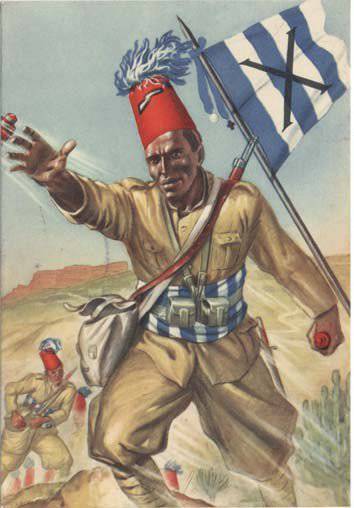
Eritrean Ascari
At the beginning of his stories Eritrean Ascari were represented only by infantry battalions, but later cavalry squadrons and mountain artillery batteries were created. In 1922, the divisions of the "mecharistov" were also formed - camel cavalry, indispensable in the conditions of the desert. Riders on camels had a turban as a headdress and were probably one of the most exotic in appearance colonial military units.
From the very beginning of its existence, Eritrean Ascari took an active part in the colonial expansion of Italy in East and Northeast Africa. They fought in the Italian-Abyssinian wars, conquered Italian Somalia, and later took part in the conquest of Libya. Eritrean Ascari gained combat experience by fighting in 1891-1894. against the Sudanese mahdists, who continually violated the borders of the Italian colonial possessions and incited local Muslims to jihad.
In 1895, the Eritrean ascari were mobilized to attack Ethiopia, which had far-reaching plans for the Italian colonial and central leadership. In 1896, Eritrean Ascari participated in the famous Battle of Adawa, which ended in the Italians' fatal defeat of the superior Ethiopian army and signified Italy’s abandonment of plans for a short-term conquest of Ethiopian lands.
However, the Somali lands, in contrast to Ethiopia, the Italians managed to conquer. Local feudal lords could not rally against the colonialists and until the end of World War II Somalia remained an Italian colony. Among the Somalis and Arabs were the Arab-Somali battalions of Ascari, who carried out garrison and police service in the territory of Italian Somalia and went to other regions of East Africa when the need arose.
1924 to 1941 in the territory of Italian Somalia, the units of “Dubat” or “white turbans” also served as an irregular paramilitary unit designed to perform police and security functions and similar to the gendarmerie in other states. Unlike the Eritrean and Somali Ascari, with respect to the Dubatus, the Italian colonial authorities did not “bother” with military uniforms and these guardians of the Somali deserts were wearing the traditional clothes of their tribes - the so-called "Foot", which was a cloth that encircles the body, and turbans, the ends of which fall on the shoulders. In the conditions of the Italo-Ethiopian war, only one adjustment was made - too much white cloth feet and a turban were replaced by Italian officers with khaki cloth.
Dubaty were recruited from representatives of the Somali clans, who roamed the border of Italian Somalia. Their task was to combat the raids of armed nomadic bandits and the national liberation movement. The internal structure of the Dubatov was similar to the Eritrean and Somali ascari, primarily because the officers in the units were also occupied by Italians, and the Somalis and Yemeni mercenaries served in the private and junior command positions.
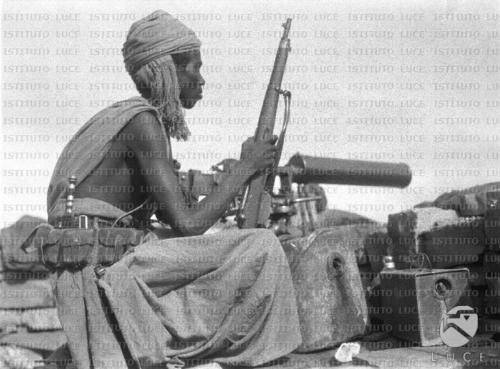
Dubat - fighter of Somali irregular troops
Ordinary Dubatov were selected among Somalis at the age of 18-35 for years, distinguished by good physical fitness and able to withstand 60 kilometers for ten hours. By the way, the weapons of the Dubats always left much to be desired - they were armed with swords, spears, and only those who passed the test received a long-awaited musket. It should be noted that it was the Dubats that “provoked” the Italian-Ethiopian war, or rather, they participated from the Italian side in the incident at the Oualyu oasis, which became the formal reason for Benito Mussolini to make a decision on the start of a military operation against Ethiopia.
When Italy made the decision in the middle of the 1930's. To subjugate Ethiopia, in addition to the Eritrean Ascari, 12 battalions of Arab-Somali Ascari and 6 Dubat troops were mobilized to participate in the conquest campaign, which also showed themselves to be good, causing serious damage to Ethiopian units. The Somali corps, commanded by General Rodolfo Graziani, was opposed by the Ethiopian army under the command of the Turkish general Vehib Pasha, who had long been in the imperial service. However, the plans of Vehib Pasha, who was counting on luring the Italo-Somali troops into the Ogaden desert, having shook them there, destroyed, was not destined to come true. In many ways, it was thanks to the Somali units, which showed a high degree of combat readiness and ability to act in the desert. As a result, Somali units succeeded in capturing the important Ethiopian centers of Dyre Dawa and Dagahgur.
During the years of Italy's colonial rule over Eritrea and Somalia, which was about 60 years, military service in the colonial units and the police became the main occupation of the most combat-ready part of the Eritrean male population. According to some reports, up to 40% of Eritrean men of appropriate age and physical training went through service in the Italian colonial army. For many of them, the colonial service was not only a means of obtaining a salary very decent by the standards of economically backward Eritrea, but also evidence of their male prowess, since the colonial units were constantly in combat conditions during the Italian presence in East Africa, constantly moving around the colonies, participating in wars and suppression of uprisings. Accordingly, the Ascari also acquired and improved their combat skills, and also received the long-awaited more or less modern weapons.
The Eritrean Ascari, by decision of the Italian government, was sent to fight against the Turkish troops during the Italian-Turkish war of 1911-1912. As a result of this war, the weakening Ottoman Empire lost Libya — in fact, its last North African ownership; . The Libyan Ascari became the third, after the Eritrean and Arab-Somali Ascari, a component of the Italian colonial forces in North and East Africa.
In 1934, Italy, by then long led by the fascists, Benito Mussolini, decided to renew the colonial expansion in Ethiopia and take revenge for the defeat in the battle of Adua. In an attack on Ethiopia in East Africa, a total of 400 of thousands of Italian troops were concentrated. These were both the best troops of the metropolis, including the divisions of the fascist militia, the “black-shirts”, and the colonial units consisting of the Eritrean Askaris and their Somali and Libyan colleagues.
October 3 1935, the Italian forces under the command of Marshal Emilio de Bono attacked Ethiopia and until April 1936 were able to crush the resistance of the Ethiopian army and the local population. In many ways, the defeat of the Ethiopian army was due not only to outdated weapons, but also to the principles of advancing not only talented military leaders to command posts, but also representatives of the most distinguished families. 5 May 1936, the Italians occupied Addis Ababa, and 8 May - Harar. Thus, the largest cities of the country fell, but the Italians did not succeed in fully establishing control over Ethiopian territory. In the mountainous and hard-to-reach areas of Ethiopia, the Italian colonial administration did not actually rule. Nevertheless, the capture of Ethiopia, the monarch of which traditionally bore the title of emperor (Negus), allowed Italy to declare themselves an empire. However, Italian domination in this ancient African country, which, by the way, the only one among other African countries, managed to maintain its independence in the era of colonization, proved short-lived. Firstly, the Ethiopian army continued to resist, and secondly, large-scale and well-armed units of the British troops came to its aid, whose task was to liberate North and East Africa from the Italians. As a result, despite the efforts of the Italians to colonize Ethiopia, already by 1941, the Italian army was withdrawn from the territory of the country and the emperor Haile Selassie again occupied the Ethiopian throne.
During the fighting in East Africa, Eritrean Askari showed high courage, which the most elite units of the metropolitan forces could envy. By the way, it was the Eritrean Askari who first entered the defeated Addis Ababa. Unlike Italians, Eritreans preferred to fight to the end, preferring death to flight from the battlefield and even an organized retreat. This courage was explained by the long-standing military traditions of the Eritreans, but the specificity of Italian colonial policy also played an important role. Unlike the British or the French, or, especially, the Germans, the Italians treated the representatives of the conquered African peoples with due respect and actively accepted them into service in almost all colonial militarized structures. Thus, Askari served not only in the infantry, cavalry and artillery, but also in automobile units and even in the air force and the naval navy.
The use of Eritrean and Somali Ascari in the Italian Navy began almost immediately after the colonization of the Red Sea coast. Back in 1886, the Italian colonial authorities turned their attention to skilled Eritrean seafarers, who regularly crossed the Red Sea in trade travels and in search of pearls. Eritreans began to be used as pilots, and later they were to be recruited by private and non-commissioned officers of naval formations deployed in Italian East Africa.
In the Air Force, native military personnel were used for ground service aviation divisions, first of all - to carry out work on protection, cleaning of airfields and ensuring the functioning of aviation divisions.
Also from the Eritrean and Somali ascari staffed Italian law enforcement units operating in the colonies. First of all, these were parts of the Carabinieri - the Italian gendarmerie, where the Eritreans were recruited in 1888 year. In Italian East Africa, the Carabinieri were called “Zapie” and were staffed according to the following principle: the officer and noncommissioned officers were Italians, the rank and file were Somalis and Eritreans. The uniform was a white or khaki color and, like the infantrymen, was complemented by a red fez and a red belt.
1500 served Somalis and 72 an Italian officer and non-commissioned officer. Ordinary positions in the mansion were staffed by immigrants from the Ascari divisions, who served in the rank of corporal and sergeant. In addition to the Carabinieri, Ascari served in the Royal Financial Guard, which performed the customs functions, the State Security Commissariat of the Colonies, the Somalia Prison Warden Corps, the Natalian Forest Police, the Police of Italian Africa. Everywhere they also held only privates and non-commissioned officers.
In 1937, East African and Libyan soldiers were entrusted with the right to take part in the grand military parade that Benito Mussolini organized in Rome in honor of the anniversary of the Italian Empire. On the streets of the ancient capital were the division of the Somali infantry, Eritrean and Libyan cavalry, sailors, police, camel cavalry. Thus, unlike Hitler's Germany, the Italian fascist leadership, which was striving to create a grand imperial state, tried not to alienate African subjects from itself. Moreover, the Italian military leaders subsequently credited themselves with the fact that, unlike the British and French, Italy had never used African soldiers in Europe, condemning the latter to fierce battles in strange climatic and cultural conditions.
The total number of native soldiers in the Italian East Africa to 1940 was 182 000 people, while the entire Italian colonial corps consisted of 256 000 soldiers and officers. The overwhelming majority of the Ascari were recruited in Eritrea and Somalia, and after the short-term conquest of Ethiopia, among pro-Italian-minded immigrants from that country. Thus, from among the representatives of the Amhara nationality, whose language is the state's Ethiopia, the Amhar cavalry squadron was formed, in which both Amharians and Eritreans and Yemenis served. For the relatively short-lived, from 1938 to 1940 years, the existence of the squadron, its servicemen had the good fortune not only to make war against the Ethiopian imperial army, but also to take part in a clash with the Sikhs - soldiers of the British colonial unit.
It should be noted that the Italians managed to raise their native warriors in such a way that even after the liberation of Ethiopia and the invasion of Italian Eastern Africa by British troops, Eritrean Ascari, under the leadership of some Italian officers, continued the guerrilla war. Thus, the Ascari detachment under the command of the Italian officer Amedeo Guillau carried out guerrilla attacks on British military units for about eight months, and Guillet himself earned the nickname “Commander the Devil”. We can assume that it was the Eritrean units that remained the last military units that remained loyal to the Mussolini regime and continued to resist the British even after the capitulation of the Italian metropolitan forces.
The end of the Second World War, many Eritrean ascari met unfriendly. Firstly, it meant defeat from the enemy with whom they fought for quite a long time, and secondly, even worse, Eritrea again came under Ethiopian control, with which the indigenous people of this desert land were not going to accept it. Much of the former Eritrean Ascari went to the partisan detachments and fronts that fought for the national liberation of Eritrea. In the end, of course, not the former Askari, but their children and grandchildren, managed to achieve independence from Ethiopia. This, of course, did not bring economic prosperity, but it gave a certain satisfaction with the results of such a long-term and bloody struggle.
However, up to the present, armed conflicts continue in the territory of both Ethiopia and Eritrea, not to mention Somalia, the reason for which is not only political differences or economic rivalry, but also excessive militancy of some local ethnic groups who cannot imagine life outside constant battles with the enemy, confirming their military and male status. Some researchers are inclined to believe that Italian colonial rule was the best era in Eritrean and Somali history, since the colonial authorities at least tried to build some kind of political and social order in their subordinate territories.
It should be noted that the Italian government, despite the official withdrawal from East Africa and the cessation of colonial expansion, tried not to forget its faithful black warriors. In 1950, a special pension fund was created, whose tasks included paying pensions to more than 140 000 by Eritrean Ascari, who served in the Italian colonial forces. The payment of pensions contributed at least to the minimal alleviation of the poverty of the Eritrean population.
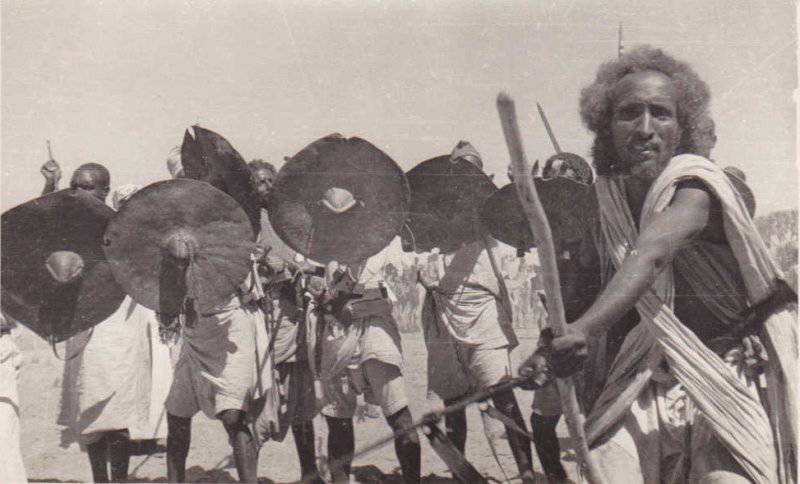
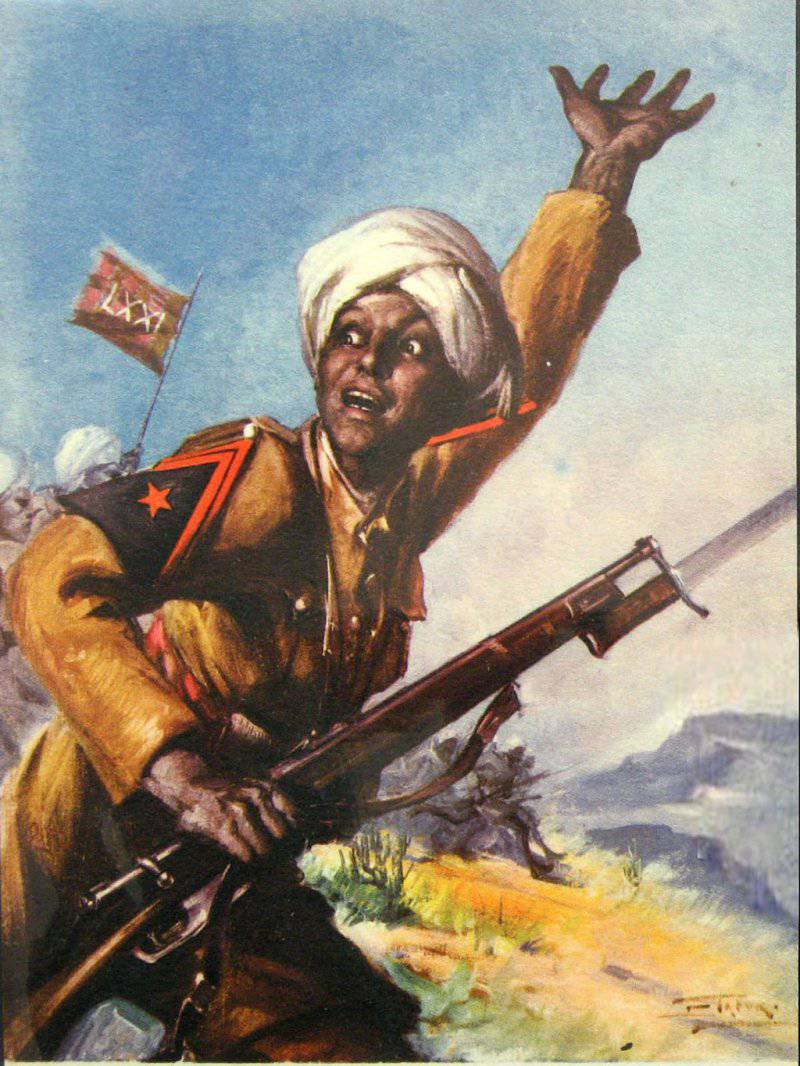
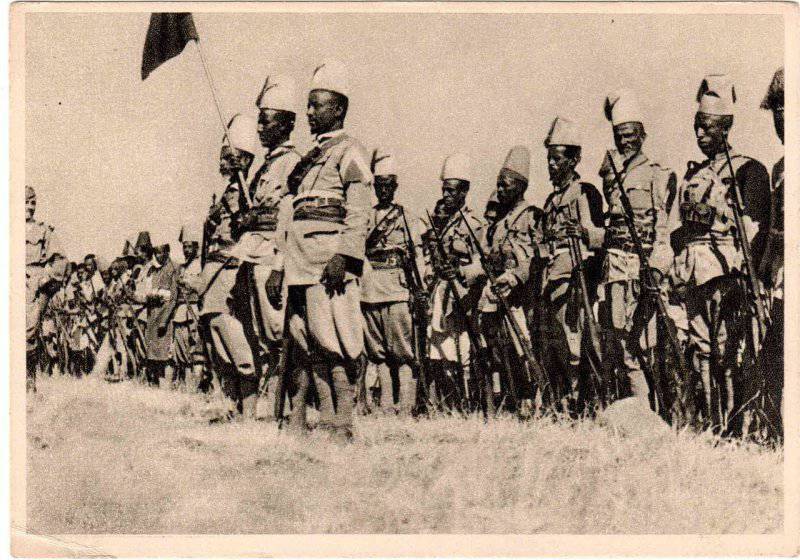
Information